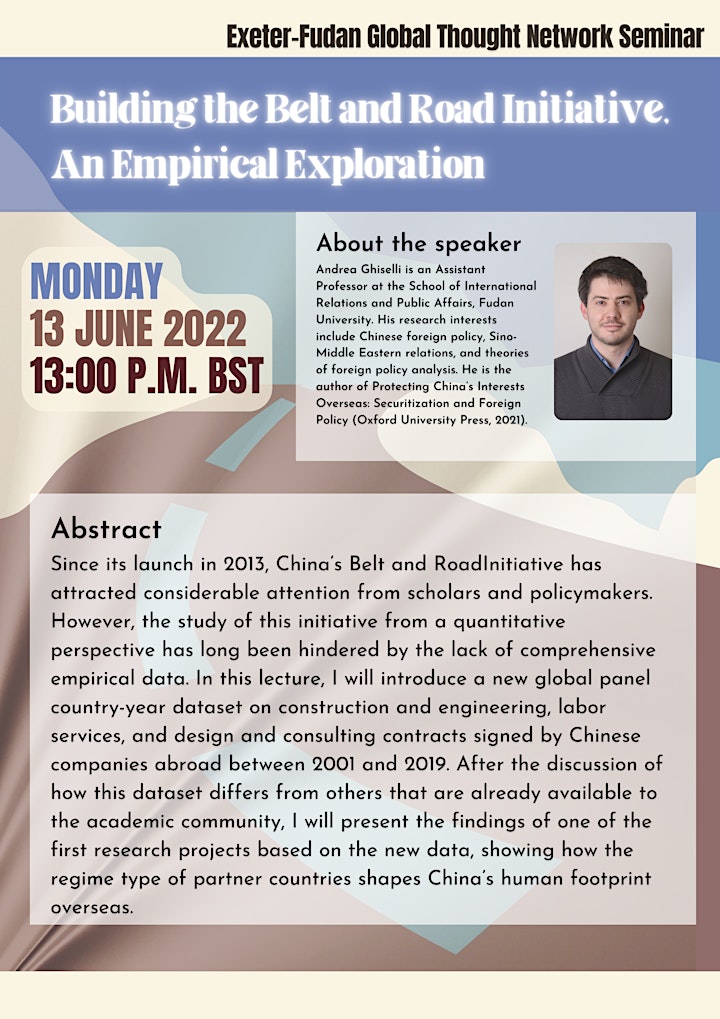Exeter-Fudan Global Thought Network Seminar 13 June 2022
Dr Andrea Ghiselli is an Assistant Professor at the School of International Relations and Public Affairs, Fudan University. His research interests include Chinese foreign policy, Sino-Middle Eastern relations, and theories of foreign policy analysis. He is the author of Protecting China’s Interests Overseas: Securitization and Foreign Policy (Oxford University Press, 2021). Link to the book. His recent publication on BRI: Andrea Ghiselli and Pippa Morgan (2021). A Turbulent Silk Road: China’s Vulnerable Foreign Policy in the Middle East and North Africa. The China Quarterly, Volume 247, 641-661. Link to the article.
In this seminar, Dr Andrea Ghiselli presented a new quantitative dataset, compiled with Dr Pippa Morgan at Duke Kunshan University, of contracts signed by Chinese companies to deliver engineering, design and consulting, and construction services with partner countries, before and after the launch of the Belt and Road Initiative (BRI). Policymakers and academics will undoubtedly welcome the insights this dataset provides into the economic and human impacts of BRI projects, which have hitherto been limited by a lack of comprehensive and comparative empirical data. “For the first time, we have an idea of the actual size of China’s footprint overseas”, stated Dr Ghiselli. Dr Ghiselli also presented the results of on-going research that explores the dataset to investigate the relationship between the presence of a large Chinese workforce and the political regime type of partner countries.
The dataset includes the yearly value of contracts between Chinese companies and partner 151 partner countries from 2001 to 2019, as well as the number of workers sent to these countries. These data have allowed for a comparative analysis of the scope of Chinese engineering and design contracts in this period, finding that the value of Chinese contracts far exceeds the aggregate value of non-Chinese investment in many countries. Statistics on the number of Chinese workers in partner countries allow for greater understanding of the human impact of these projects, such as how local communities may respond to the presence of foreign workers, particularly where domestic unemployment rates are high. Research findings also reveal that whilst Sino-Africa economic relations dominate Western academic literature on Chinese foreign economic policy, the main focus of Chinese investment is South and South-East Asia.
Dr Ghiselli highlighted how the data reveals that changes have taken place since the BRI was launched in 2013 in the way Chinese companies act in partner countries. The scope of investment, contract length, the revenue gained from contracts and the employment of Chinese rather than domestic workers have all increased over time. The limitations of some of the data were highlighted, including how the ‘gross income’ of contracts often serves only to indicate the relative amount of work done per year, not the accurate annual revenue in each case. Moreover, data on the numbers of Chinese workers present in partner countries ought only to be interpreted as snapshot data rather than information on the total number of workers in that year.
From this dataset, Dr Ghiselli and Dr Morgan delved more deeply into the relational dynamics between Chinese companies and partner countries, exploring why many economically poor countries with large populations, often with high unemployment rates, frequently host large numbers of Chinese workers. The possible reasons for governments accepting large numbers of foreign workers were outlined, such as training opportunities for lower-skilled local populations and an unwillingness or inability of locals to do the work demanded by investors. With research focused on Algeria and Ghana, they explore the hypothesis that the less democratic a country’s regime, the more likely they were to host larger numbers of Chinese workers. They argue that performance-based legitimacy was central to this likelihood, as well as non-democratic countries seeking to rely as little as possible on their own populations as workers who may be driven to organise more greatly into trade unions or make political demands of their governments where foreign workers would not.
During the discussion of Dr Ghiselli and Dr Morgan’s work, participants raised questions about the possible differences in the number and proportion of Chinese workers between the more democratic countries and the less democratic ones, between the more open countries and the more close ones, and also between different infrastructure sectors and different kinds of the Chinese company, and touched a wide range of questions including the theoretical claims of this dataset, Chinese presence in Pakistan, the potential impact of Covid-19 pandemic on the Belt and Road Initiative.
